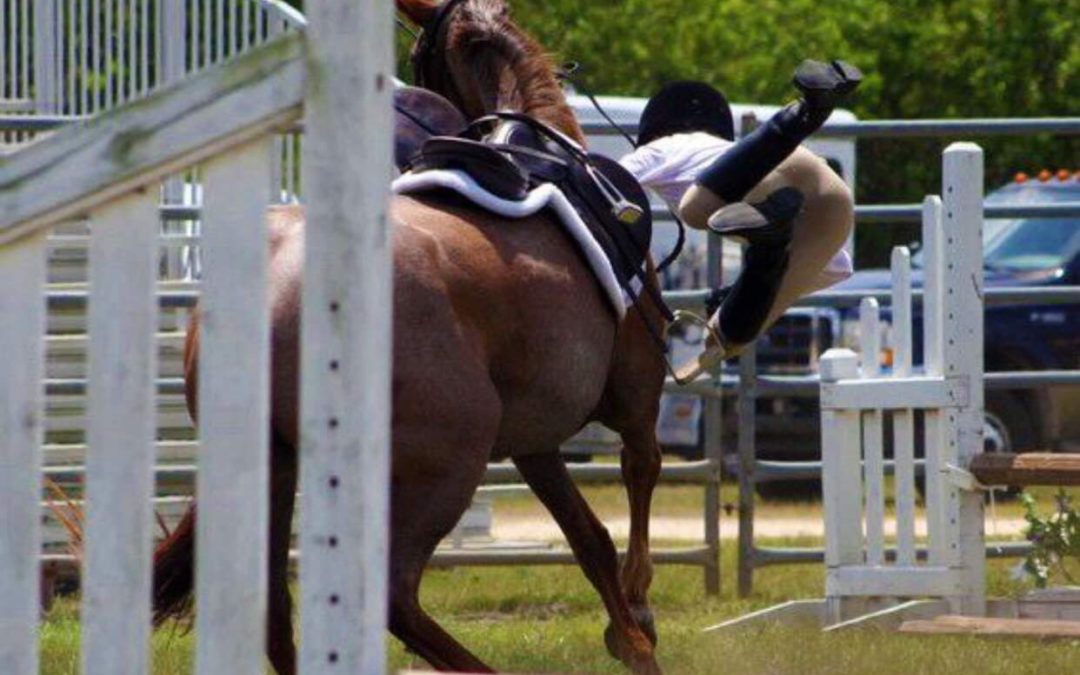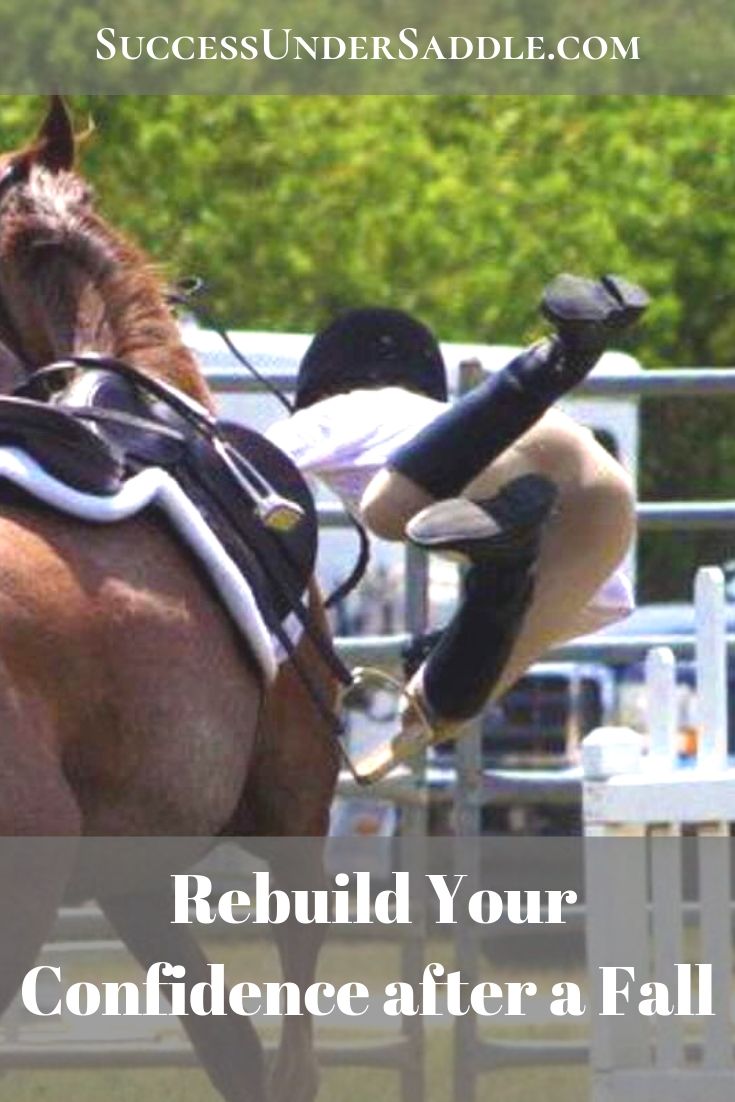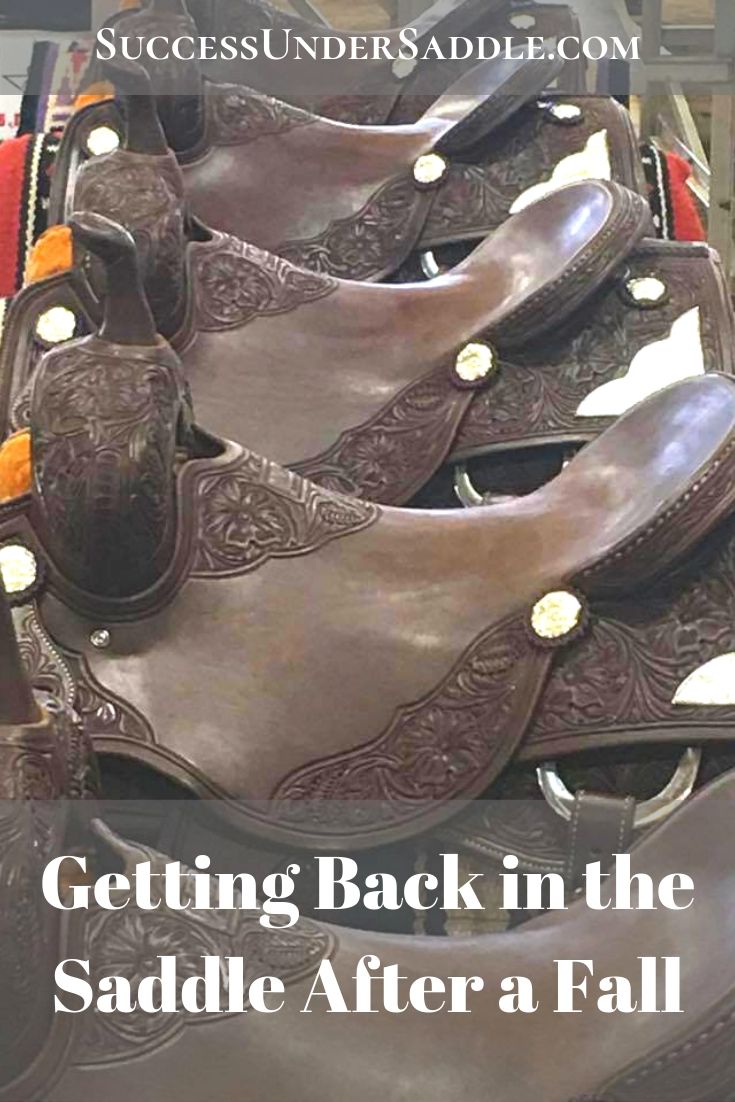Some people can have a fall, pick themselves up, dust themselves off, get back on their horse and carry on as if nothing had happened. But other people, especially those of us who are a bit older, find that it can be very difficult to do. The ground seems to get harder and we don’t bounce back as easily as we once did.
If you ride horses, falling is somewhat inevitable. It’s part of the sport. In fact, there really isn’t any athletic sport that you can do where falling could be a risk.
Even if you’re not injured physically, a fall can leave you feeling emotionally shaky. Even if you’re not seriously injured from the fall, you’ll likely be stiff, sore and bruised. Sometimes you don’t even need to fall off. Having a near miss or seeing someone else take a fall can be enough to shake our confidence.
Injuries don’t just cause physical trauma, they also cause mental scarring. Thoughts that can make you hesitate, overthink and freeze when you are trying to get back into the saddle.
Because of the injury your mind has become sensitive that it can happen again. Falling off a horse has more impact mentally as well as physically than most other sports.
Even if you’re not hurt, it can leave you feeling less confident and worried about what could happen. That’s because we don’t always feel that we have control of the situation. Sometimes there is no warning that your horse was about to blow up, refuse, or bolt.
What Fear Really Is
Fear is a very useful emotion. Obviously, if we didn’t have any fear, we wouldn’t be able to tell if we were in danger. Still, fear in excess, can be paralyzing and irrational.
Having a major riding accident is like having any kind of accident for the first time, it shakes our belief system. As human beings, we have this tendency to go around thinking we are invulnerable until something comes along to challenge that notion.
The reactions you may experience after an accident will vary, but there are four general ways in which people may respond:
Reaction Avoidance
You may avoid going out to ride, or make excuses about why you can’t have a lesson or do a particular exercise.
Freezing
You may assume that you can get back on and jump that oxer, but then find yourself pulling the horse up or away from the fence.
Being Jumpy
You may respond by becoming ‘hyper vigilant’, or extremely conscious of every move you or your horse makes. If you are experiencing such a reaction, you will probably find it hard to ‘let go’ and just ride.
Anxiety
Finally, you may experience a reaction in the form of excessive anxiety that was not present prior to your fall. Butterflies are going crazy in your stomach, your heart is pounding and you feel as though you might pass out. It may feel very much like a panic attack.
Fear is the most common cause of:
- Getting re-injured
- Second guessing your abilities and overthinking
- What if thinking
- Freezing, choking and getting paralyzed
- Getting stuck on a plateau
- Making crucial mistakes and getting seriously injured
The first serious injury can be a hard thing to get over. For some, it’s the end of their passion. When you’re pushing yourself and improving, you’re bound to make mistakes and some of them lead to injuries.
Injuries can lead to a lot of mental blocks that can require mental techniques to unblock. Mental scars left by an injury can corrupt your confidence and lock you up on a plateau. Fear of re-injury keeps many athletes of all sorts, riders included, from ever regaining back their confidence.
Injuries Don’t Discriminate
The first thing to understand is that injuries are not discriminating; they do not care about who you are, how hard you train, how careful you are about rest and recovery, or how deserving you are. When you get injured it’s easy to fall into a victim mentality telling yourself that “it’s not fair.”
Once you recognize that fairness is not at play, you can eliminate a heavy burden and focus your energy elsewhere, such as healing, managing your emotions, and dealing with the pain from the injury.
Identify the Cause of the Fall
Before you mount up again, think about why your fall occurred. Were you jumping a fence and missed the timing? Did your horse rear or buck? Did your horse slip around the barrel? Did you lose your balance? Perhaps you were distracted by thoughts outside of the task at hand and lost concentration because of it.
Identifying what caused you to fall can help you to take measures to prevent a similar fall in the future. Accidents occur for many different reasons, and how deal with it will in large part depend on this factor.
Analyzing the fall also tends to have a calming effect, as you shift into a logical mode of thinking as opposed to an emotional one. It provides a bit of control.
Once you’ve figured out what the cause was, you can work out a plan for resolving the cause and moving forward with your training. With a well thought out plan, you will be able to eliminate the “what if” thinking, self- doubt and the feeling of not having control.
Try these tips to re-build confidence after an injury:
Build Physical Strength
Build physical strength and basic skills to increase your sense of physical security in the saddle. You don’t necessarily need to ride for this. It can be just as effective for you to go to the gym and work on those parts of your body that need strengthening. I wrote an entire article on building core strength. You can refer to it here.
If you fell because you lost your balance, for example, work on exercises that you can perform to improve your balance in the saddle. If you fell because your horse bucked or reared, then it might be time to have a trainer work with your horse to correct this behavior.
Your injury may require a difference in how you approach certain riding skills. Going back to basics in your riding can not only increase your sense of security on a horse, but also give you something positive to focus your attention on.
Visualize your Recovery
Visualization is often spoken about in the context of creating a mental picture representing some kind of success. Visualization is also an important component of mental healing during or after an injury. This means you should visualize yourself being healthy, going through motions of your rehab, and seeing yourself executing you’re riding with perfect form
Ride a Trusted Horse
When rebuilding confidence, it’s important to have an appropriate mount. Ride a horse that you trust. Now is not the time to try and ride your project horse. Horses pick up so much from the rider. If you’re terrified, you’re not sending a good signal to that horse. Ride a horse you can relax on until you’re comfortable in the saddle again.
Work with a Trainer or Instructor
After a fall, it’s a good idea to work with a trainer or riding instructor whom you trust. A good trainer can build your confidence back up by gradually pushing you outside of your comfort level. A trainer can also spot weaknesses in your riding and work with you to improve them, leaving you feeling stronger and more confident in the saddle
Trainers and riding instructors play an important role in the rehabilitation of any rider’s injury, not only in the physical rehabilitation of the injury, but also helping riders mentally get back in the game. For tips on finding a trainer or riding instructor, check out this article here.
Eliminate Negative Self Talk
If you can focus on what you can do, you can prevent negativity from corroding your mindset. Maintain a positive outlook. Your attitude toward returning to riding is everything. Fear only serves to hold you back from your potential.
Saying things like “I know I will fall off again if I try that fence” basically limits your ability to believe in yourself and your own abilities. It diminishes your ability to make positive changes.
Learn to notice when you’re being self-critical so you can begin to stop. Notice when you say things to yourself that you wouldn’t say to a good friend or a child.
Relationships can be tested after an injury. Often ones self-esteem is tied very closely to our riding and our relationships through riding. Thus, dips in our ability to ride due to a prolonged absence can leave us drowning in self-pity and low self-esteem. Self-esteem can be raised through other means though, such as learning a new skill or through mental exercise.
Take Your Time
When you have an injury or fall, where do you start again? The best advice is to go backwards and find your comfort zone. You start there.
Give yourself permission to take things slow and you will find that your confidence gradually returns to you. Be patient.
The best way to rebuild your confidence is by having positive experiences. This may mean ‘bumping down a notch’ in terms of what you do in lessons, such as jumping smaller jumps or not riding without stirrups. . You go back to where you feel comfortable and build on that.
Once you get that secure, then take your next step. If it’s only a half-step, great. You always build on a solid base. So, go back to basics and enjoy the ride.
If you were competing when the injury occurred, set manageable goals for your return to competition. Once you are fully recovered, you can adjust your goals upward. By not setting your goals too high, you will keep anxiety at bay and steadily increase your confidence with each step forward.
Do not compare your post-injury self to your pre-injury self…yet
Eventually, you will get back to your riding pursuits, so do not be tempted to test your pace and fitness level by doing something that can set you back. Let your pace and fitness build organically as you continue to heal.
Flip the Perspective
Mental Toughness Coach and Pro Snowboarder, Jussi Tarvainen offers 5 ideas on how an injury can actually benefit your life. Consider this:
#1 Health
Your injury may have forced you to make some changes in your health and lifestyle. Maybe you had to go to the gym, change your eating habits or exercise regularly. Maybe it forced you to get more rest. This is a benefit to you!
#2 Master Your Headspace & Mental Game
Learning “mental tricks” that could help you overcome the mental blocks holding back progress.
#3 Gamifying Recovery – setting goals and mastering motivation:
Setting deadlines to get back into the shape Getting clear on goals and setting out an action plan.
#4 New Habits and Progression Systems:
Getting rid of bad habits that take you further from your goals and not bringing fulfillment. Replacing those bad habits with positive habits like going to the gym, studying and working on other passions. Building systems and focus on doing instead of thinking. Realizing that goals are reached by consistently doing the things that produce.
#5 Personal Development:
Learning how to set your mind and guarantee that you stick to your plan. Discovering your strengths.
A Final Note
Injuries are brutal. Remind yourself that you survived. It happens; we fall off. You fell off and you lived to tell the tale. Remind yourself that falls happen to everyone, and that they’re a part of riding. And most of the time, we escape from falls relatively unscathed. For more tips on Riding With Confidence, click here.
Above and beyond everything else, do not let an injury shake your resolve or make you doubt who you are. Remind yourself that you are a skilled and capable rider, and that you can handle a fall if it does happen again. Let me know how you overcame a scary fall in the comments below!
Horse selection is key when it comes to building confidence and trust in your horse. If you are looking for your first horse or your next dream horse, then you will want to get my free Dream Horse Buyers Guide! It’s full of everything you need to know to narrow your search and select your next equine partner! Get it today by clicking the button below!
Enjoy the Ride!



